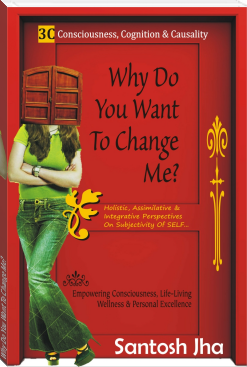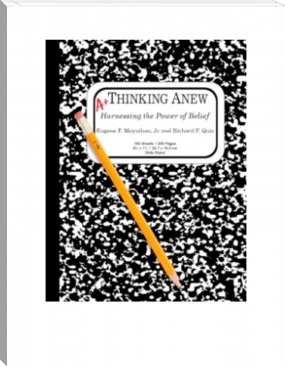Why Do You Want To Change Me? by Santosh Jha (books to read for 13 year olds .TXT) 📕

Read free book «Why Do You Want To Change Me? by Santosh Jha (books to read for 13 year olds .TXT) 📕» - read online or download for free at americanlibrarybooks.com
- Author: Santosh Jha
Read book online «Why Do You Want To Change Me? by Santosh Jha (books to read for 13 year olds .TXT) 📕». Author - Santosh Jha
To come out of this cyclic causality of gratification and renunciation, which takes one away and aloof from this powerful drift is the role and function of this super consciousness. This is the difficult part of the entire idea of consciousness. This is probably an idea, which is tough for the consciousness to imagine. The practice of it is far more difficult. The yoga philosophy says, there is a state of super consciousness, which is called ‘kaivalya’. This Sanskrit word has almost no parallel word in modern languages. We can say, it literally means a state of singleness, a conscious position of onlyness.
For most of us, it is difficult to understand its true meaning as since long; we have been accustomed to collective and mutual existence and awareness of self. There is so much of contemporary culture within our conscious and subconscious minds. We are so used to our consciousness in complete collaboration and concomitance with our external as well as internal milieus that for us, an idea in the domain of total and perfect singleness and onlyness is beyond even imagination. The idea, as elaborated by Indian spiritual philosophy enshrines that super consciousness is a state of being, where there is complete and perfect lack of any connection, causality and coexistence between the drishta and drishya. The subject, the consciousness, which observes the nature and the decision-making matrices of life, becomes completely free and detached from the causality and utility of external as well as internal milieus and nature. This super consciousness is a state of singleness and onlyness – the kaivalya state of consciousness.
The idea is – in both the consciousnesses of gratification as well as renunciation, if there is causality and utility of the subject with object, the consciousness acquires the element of ego and sense of self, as distinct and different from others. This ego has to go in the state of super consciousness, as this element of sense of self is actually a mortal and discontinuous element. Kaivalya is a state of consciousness, which is devoid of ego and sense of self as this state is the true element of immortality and continuity. The singleness and onlyness has only a singular element of continuity and immortality. This sense of self needs to go away then only one can truly attain the state of kaivalya, the state of singleness and onlyness.
This is very tough. There have been people on earth, who attained greatness and even understood the utility of it all. They became saints and helped the masses. Still, they could not devoid themselves of the sense of self, and this made them create rifts between different persons. The evil, which all cultures portray in human beings is this sense of self, which remains attached to egoistic attitudes. Kaivalya is possible only when this sense of self withers completely. Even greats are affected by the attributes of inertia and they stop practicing when they attain greatness. This dooms them and humanity. Kaivalya needs to be practiced lifelong.
This is the state, in yogic philosophy, where jeevatma (human soul/consciousness) unites with parmatma (cosmic soul/consciousness). This is what they called yoga, the union. The different yogasanas are different ways to discipline your body and consciousness to arrive at the state of kaivalya. This is also something, the spiritual philosophy of Geeta, the chief holy book of Hinduism says. Somehow, the modern concepts of psychosynthesis and psychoenergetics also work around the similar ideas.
There is a cardinal rule to the success of every enterprise of life. At the start, every enterprise looks huge and tough. Human mind, as we discussed, is not good at seeing far ahead. Therefore, it is always advised to take small steps towards achievement of part of the enterprise and set aim for smaller goals. Your innocence and honesty is your best preparations to attain your goals. The simple idea is; it is your imagination, which makes you a winner, when you have to make any important decision in life. This imagination puts you above and aloof from the immediate milieus, culture and body-mind instincts, which often either blur your judgment or keep you in a flux. Worse, it makes you drift with it, beyond your conscious control.
You have to use your power of conscious imagination to accept your being and self as someone, not only your body, not only your mind, not only your milieus and not even the interaction between them. You have to accept it as some super consciousness, which observes each of your thought-action-behavior matrices from a position above and aloof from all the dimensions of your consciousness and being. This enables you to hold every emotion, instinct and ideas back for a while, sit over them with an objective and independent super consciousness.
As this super consciousness is a receptive mode facility, you shall be endowed with a power to observe and control all your instinctive and culturally induced thought-action-behavior of action-reaction mode. As you keep practicing to remain in this super consciousness self, you shall finally attain the kaivalya realism. Then, this super consciousness shall become your single and only consciousness.
This is the stage where, you become the conscious decider of what should ideally present yourself with your decision-matrix at any point of time in your life. This is a sure facility for personalizing your own wellness and making them independent of milieus, culture and instincts. Anything you wish to attain in life, in societal milieu, which cultural benchmarks label as worthy, you shall decisively find yourself in competition and conflict with so many others, who want the same attainment and that too exclusively. The success of the enterprise shall only partly depend on your efforts and merits as there shall always be many factors in milieu and people, which shall be equally decisive.
That is why successes in our societies are exception, not a rule. However, when you wish to attain something, which is possible only just by your simple and innocent resolve, you shall be always successful. Like your resolve to find utility and worth in intangibles like love, compassion or attach value to being in nature with trees and birds is only your own personal attainment. This enterprise is successful any number of times you do it. For example, the worth the woman in love in our story above created in a pebble, installing more value to it than a diamond, shall always remain with her as this is an intangible utility, nobody can take away from her, unlike a real diamond. The ancient philosophies tell us to align ourselves only with these intangibles as utility because; our own consciousness has worth only as intangible. Our consciousness is intangible and continuous and that is why, it shall find lasting and continuous wellness only in intangible elements. That is why, the philosophy prescribes, true and lasting relationship can happen only between similar and generic elements. Our consciousness is intangible and values the intangibles in our lives more than anything. If we align our consciousness with value, worth and utility in tangibles, there is bound to be pain, conflict and confusion as these elements are not similar and generic to the true character of our consciousness. This is the change we all need to instill in our conscious mind.
This power of imagination, our super consciousness has, is our most precious endowment but this treasure has to be protected against misuse. This is best ensured when you have innocence and honesty of character. You need to be cautious that you keep yourself in milieus, both internal and external, which are conducive to protecting and prolonging your innocence and honesty. If not, then this power of imagination shall always be involved with your ego and sense of self, which shall then lead you away from objectivity and innocence of imagination. You shall then begin to be intelligent, instead of innocence and subjective in assigning value and worth to possessions. That is why I said at the very start of this book that “the questions you possess is half your destiny, the answers you accept remains the other half but, both halves of destinies are poorly linked by a narrow strip of pathway or a bridge called ‘innocence of consciousness’ across an ocean of dualism.”
The kaivalya state shall be unavailable, as this sense of self shall put you in the groove of subjectivity, making you trapped in the cyclic causality of action-reaction. It is equally important that the body-mind entity remains ensconced in a conducive internal and external environment. This is crucial initially. Once you have attained the kaivalya state, you can live in any milieu, as you would then rise above all to be affected by them. Initially, you have to keep away from contemporary milieus and culture of gratification and action-reaction mode.
**
‘Unlearning’ Is Larger Intelligence
Lateral, plural and unfounded behavior patterns, attitudes, perspectives, hypotheses and mindsets created by the popular culture, which are based on their subjective notions, have made us what we are today. Accepting something new and contrary to our mind and cultural training would be not only tough but also very painful for us. The experts say, “The process of understanding one’s ‘self’ is pitted against one’s own beliefs about one’s ‘self’. ‘You’ are in your perspective and your perspective is in ‘you’. Escaping this trap requires challenging everything that ‘you’ believe.” That is why, the larger intelligence for we all in contemporary socio-cultural milieus is to ‘unlearn’, as we have erroneously learnt so many things, which are now being challenged by the new wisdom as obsolete and un-useful. This is the major change call.
That’s why, the first requirement is this huge courage, determination and resilience in our part to come out of this mould and accept an entirely new mindset which shall look like as completely contrary to what we so far hold as not only true but ‘sacred’. We need to be accommodative to this new knowledge and modern objective facts about our core mechanisms, parallel to our traditional cultural ideas and benchmarks. Holism, assimilation and integration is the ‘intelligence’, which shall help us in effecting a major change in accepting ideas about the questions related to consciousness, cognition and causality.
We need to consciously and continuously tell our mind that look, we are in the midst of a huge change and we are introducing some new ideas and notions that is going to be the new and additional matrix, equally important, if not superior than the traditional one, for a new and objective value summation and decision-making. Reiterate that resolve to your mind repeatedly as it is only through conscious repetition that mind accepts external inputs and then forms it as part of its instinctive value summation programming, or what people popularly refer as ‘soul’ or ‘higher conscious’.
For example, His Holiness Dalai Lama said, “Pain is inevitable, suffering is optional”. This may sound like a philosophy or spiritual message but it has the total backing of science. Science is seldom against what true philosophy and spiritualism enlists as good





Comments (0)